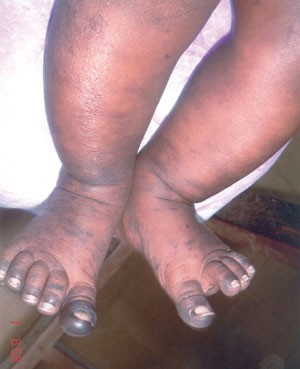A one year old boy was brought for blackish
discoloration of toes following high grade fever for 3 days. On
examination, a grayish black macular rash was seen over the legs and
trunk. All the toes were looking black simulating gangrene (Fig.1).
However the distal pulses in the feet and capillary filling time over the
toes were normal. He was alert, afebrile and other systemic examination
was normal. As his mother also had fever with similar rash over her body
concurrently, Chikungunya infection was considered and the same was
confirmed by a positive PCR for Chikungunya RNA in his plasma. After two
weeks, the rash disappeared following desquamation.
 |
|
Fig. 1 Toes looking black simulating
gangrene. |
Gangrene of the digits can occur with obstruction of
vascular supply, infections like chicken pox and immune-mediated
conditions like Systemic Lupus Erythematosus and Polyarteritis nodosa.
Purpura fulminans due to severe septicemia or deficiency of protein C and
S can also cause the same. Acrocyanosis or blackish discoloration of
digits may occur after prolonged exposure to cold. Hyperpig-mentation and
desquamation may also be noted in post measles state.

